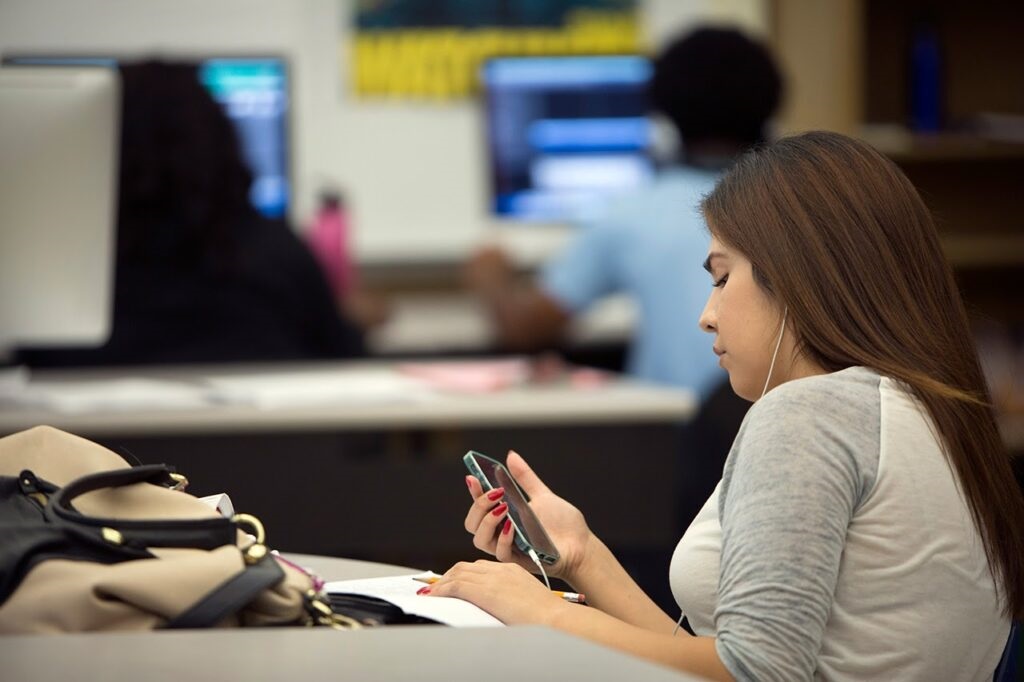California would become the fifth state to require public schools to restrict or ban student smartphone use on school grounds under legislation Gov. Gavin Newsom has supported and is expected to sign.
The bipartisan Phone-Free Schools Act — Assembly Bill 3216 — would require school districts to enact smartphone restrictions by July 1, 2026, and review policies every five years. If enacted, California would join Florida, Indiana, Louisiana, South Carolina and Ohio in passing statewide cellphone use restrictions on public school campuses.
“Now is the time to require rather than just authorize all school districts to take measures to not only support student success by limiting or restricting smartphone use but to protect their teenage mental health,” said Democratic Assemblymember Al Muratsuchi, who co-authored the bill.
Newsom, who has been very vocal about supporting cellphone restrictions on school grounds, previously approved legislation in 2019 — AB 272 — authorizing school districts to limit or prohibit students’ use of cell phones at school. In June, he said he planned to build on that law to further restrict students’ cell phone use but did not offer details.
The governor again emphasized the importance of smartphone restrictions earlier this month when he urged educators in a statewide letter to immediately restrict cellphones on campus as students return to the classroom.
The Phone-Free bill was authored by Muratsuchi of Torrance — who also authored AB 272 — along with Republican Assemblymember Josh Hoover of Folsom and Democratic assemblymembers David Alvarez of Chula Vista and Josh Lowenthal of Long Beach.
“We’re Democrats and Republicans, but what we all have in common is we’re all parents, and we’ve all seen this firsthand,” Hoover said. “I strongly believe that this is an area of statewide concern.”
Muratsuchi said he introduced AB 272 not only as a state legislator but as a father of a teenage daughter. Growing research shows a relationship between teenage smartphone use and anxiety, depression and suicide, he said, making the need for smartphone restrictions more important than ever.
The governor’s letter to schools cited a Pew Research survey that found that 72% of high school and 33% of middle school teachers report cell phone distractions as a major problem and a Common Sense Media survey that found that 97% of students use their phones during the school day for a median of 43 minutes.
Hoover said the key difference between AB 3216 and the existing 2019 legislation is that, now, every school in the state will be required to pass policies limiting smartphone use during the school day and revise those policies every five years. He said there are no specific requirements for districts in the bill in order to allow flexibility for schools to choose how to restrict or ban cellphone use.
The California School Boards Association, which represents the state’s public trustees, has strongly opposed the bill, which it says does not account for the substantial demographic and ideological differences between the state’s 940 school districts and 58 county offices of education.
Troy Flint, the association’s chief communications officer, said proponents on both sides of the argument are “well-intentioned” and trying to do what is best for students’ safety and mental health.
“We don’t object to cellphone bans in the abstract, and we encourage districts to investigate whether that makes sense for them,” Flint said. “We do object to the blanket statewide policy.”
Flint said the association disagrees with Hoover on whether the bill respects local control “to the necessary degree.”
“We have a lot of different situations in California,” he explained. “Kids traveling on a bus an hour to school … Kids with disabilities … This is a rare issue where everyone is well-intentioned and trying in their own way to do what they think is best.”
Hoover confirmed that the Phone-Free Schools Act does not remove any of the current exceptions to existing legislation — including in cases of an emergency or when students have permission to use their phone in class.
Existing law also states a student has the right to access their phone in response to a perceived threat of danger, like a school shooting or lockdown.
The bill is supported by the Los Angeles Unified School District — which voted earlier this summer to ban students’ use of phones beginning in 2025 — and the California Teachers Association, one of the state’s major teacher unions.
“Our union has supported improving school environments and restricting the use of smartphones on campuses,” said David Goldberg, the teacher’s association’s president.
Bay Area schools have been split on the issue. Some schools have expressed support over smartphone restrictions, including San Mateo High School, which became a phone-free campus in 2019.
Others, such as Livermore Valley Joint Unified School District and Palo Alto Unified School District, have said cellphones are necessary for many families, and proposed bans don’t make sense in schools that rely on technology to support students’ learning.
Muratsuchi said smartphones are still relatively new, and society still is adjusting to its impacts.
“We need to rethink this culture of constant access to smartphones,” Muratsuchi said, “given the growing evidence of the detrimental impact on student education as well as their mental health.”
Originally Published:
